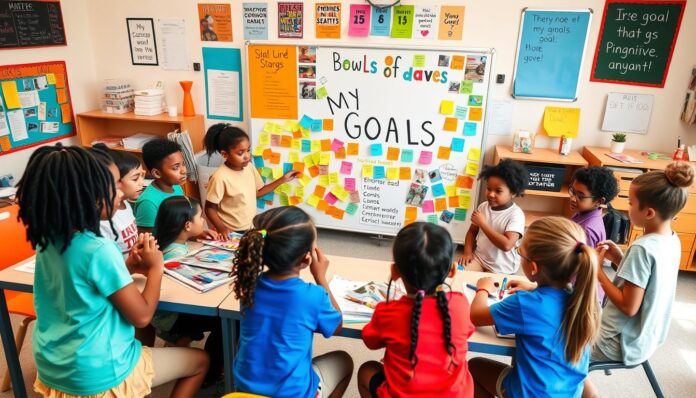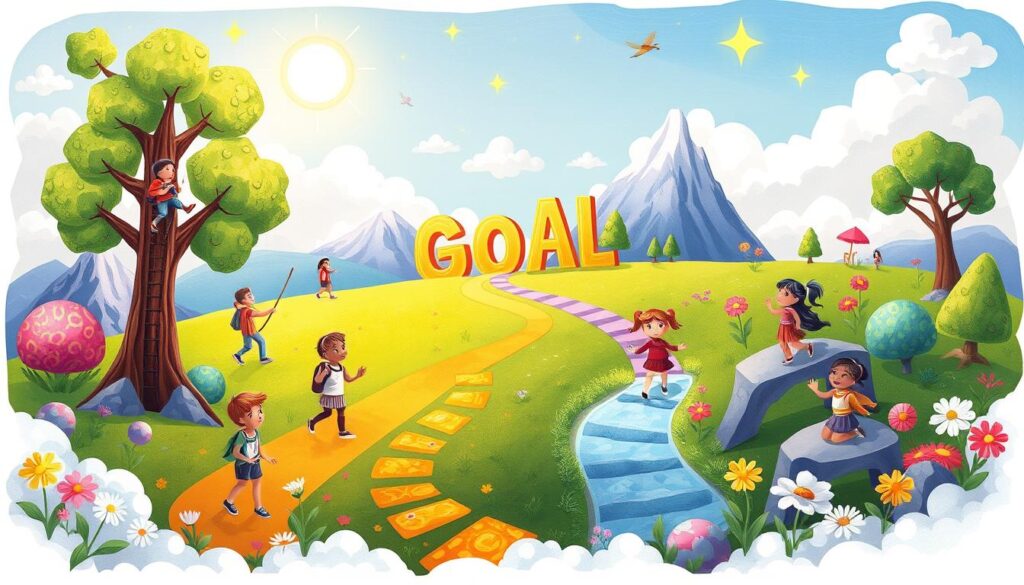On a chilly autumn afternoon, 13-year-old Emma sat in her room. She stared at a blank page in her journal. Her teacher had given her a goal-setting exercise, and Emma was eager to start.
She knew setting goals was important for her growth. But, the task seemed hard. Little did she know, this simple task would change her life.
Goal setting for youth is about empowerment, resilience, and self-discovery. This guide will show you goal setting activities for youth. It will help young minds face challenges, learn from failures, and reach their dreams. If you’re a parent, teacher, or mentor, you’ll find ways to empower kids and help them grow.
Key Takeaways
- Understand the importance of goal setting activities for youth in developing a growth mindset, resilience, and personal growth.
- Explore interactive exercises and lessons that engage young learners in goal planning for teens and adolescent goal achievement.
- Discover how to cultivate a supportive environment for youth objectives and targets, fostering teenage personal development.
- Learn effective strategies to guide empowering young minds through the goal-oriented youth activities and teenage motivation techniques.
- Uncover the transformative power of youth aspiration programs in unlocking the full young learners.
The Power of Setting Goals: Unlocking young minds
Having a growth mindset helps kids be more resilient and learn better. It lets them see challenges as chances to grow. Positive affirmations are key in building this mindset and making learning fun.
Studies show that positive affirmations boost optimism, resilience, and brain function. They also improve overall well-being.
Teaching kids to be curious is important. It helps them see challenges as chances to learn and grow. Goal setting is a great way to teach this, as it builds life skills like decision-making and self-discipline.
Empowering Young Minds through Goal-Setting
Setting goals that match their interests makes teens more motivated. Surveys show that teens with a growth mindset handle challenges better. They also value effort more.
Reaching goals boosts teens’ self-esteem and confidence. This makes them more resilient and ready for the future.
Fostering Resilience and Positive Attitude in Youth
Using tools like planners and apps helps teens stay focused on their goals. Parents playing a role in goal setting is key. It’s important to guide without being too controlling.
“Effective goals are achievable, believable, and committed – the A-B-C of goals according to Frank L. Smoll.”
Teaching teens to break down goals into steps is helpful. It builds a positive mindset and encourages seeking help when needed. The S-M-A-R-T rule for goal-setting makes goals more likely to succeed.
Interactive Activities to Foster Goal-Setting Skills
Goal-setting exercises for youth can unlock their true abilities. Interactive activities help grow a growth mindset and teach valuable skills. These exercises encourage kids to see learning as fun and mistakes as chances to grow.
The ‘Yet’ Pathway and Mistake Masters
The ‘Yet’ Pathway changes the game by teaching persistence and a positive learning attitude. It shows kids they haven’t reached their goals or mastered skills yet. This boosts their view of their learning journey.
The Mistake Masters activity teaches kids that facing challenges and making mistakes is part of learning. It builds resilience and a growth mindset.
Kindness Challenge Quest and Escape Room Adventures
Games like the Kindness Challenge Quest and Escape Room Adventures get kids involved and motivated. They teach problem-solving, teamwork, and perseverance. These activities keep kids excited and focused on their goals.
By using these goal-setting exercises for youth, we create a supportive environment. Kids learn to face challenges, see mistakes as chances, and grow. These growth mindset games for kids help them tackle youth objective-based challenges and reach their full capacity.
“The future belongs to those who believe in the beauty of their dreams.” – Eleanor Roosevelt
Goal Setting Activities For Youth: Nurturing Personal Growth
Helping youth develop a growth mindset is key. Goal-setting journals empower kids to set goals and track their progress. Self-esteem boosting exercises help build confidence and show that hard work pays off.
Activities like Word Search Wonders and Success Bulletin Board teach important vocabulary. They celebrate achievements, boosting a growth mindset in young learners. These tools keep kids motivated and focused on their goals.
Empowering Self-Reflection and Awareness
Research shows that writing down goals helps students achieve them. Dr. Gail Matthews found that weekly updates double the chances of success. This highlights the need for consistent effort in reaching goals.
- Sharing goal progress with the class boosts accountability.
- Celebrating goal achievements motivates others to strive for their goals.
- Teaching goal-setting skills improves academic and personal growth.
Reinforcing Growth Mindset Through Activities
Activities that focus on vocabulary and achievements are vital. Word Search Wonders and Success Bulletin Board make learning fun. They help kids see their progress as something to be proud of.
“Setting specific and measurable goals, like selling 20 cups of lemonade for $1 each by the end of the day, aids children in achieving success.”
These youth personal development activities highlight the value of goal setting. They celebrate the journey, promoting a growth mindset and a sense of accomplishment in young learners.
Parental Involvement: Building a Supportive Environment
Parents are key in helping kids develop a growth mindset. By showing and encouraging a growth mindset, they help young people reach their full abilities.
Fostering Family Involvement in Goal-Setting
Getting the whole family involved in setting goals is a great way to support kids. It makes communication better and helps kids see their goals as a team effort.
- Successful relationships focus on families’ strengths and shared commitment to the child’s well-being and success.
- Positive interactions with caregivers help children develop skills for success in school and life.
- Healthy parent-child relationships are a key predictor for children’s success in early learning and healthy development.
By getting the family involved in goal-setting, parents can help their kids grow. This empowers them to achieve more.
| Benefit | Impact |
|---|---|
| Improved Academic Performance | Research shows that parents involved in education lead to better grades. |
| Enhanced Motivation and Engagement | Parental involvement boosts kids’ motivation and interest in goals. |
| Stronger Parent-Child Relationship | Working together on goals can make the parent-child bond stronger. |
By supporting and joining in on goal-setting, parents can help young minds grow. This creates a lifelong love of learning.
The SMART Approach: Guiding Kids Toward Achievable Goals
Setting clear goals is key for youth to reach their best. The SMART method helps kids set goals that are specific, measurable, achievable, relevant, and time-bound. This way, they can aim for real goals, not just wishes.
Using the SMART framework, you can teach kids how to set goals. It helps them break down big goals into smaller steps. This makes sure their goals are clear, easy to measure, and achievable.
- Specific: Encourage kids to make their goals clear, like “learn to play the piano” or “read 20 books this year.”
- Measurable: Help them figure out how to track their progress, like keeping a reading log or practicing piano regularly.
- Achievable: Guide them to set goals that are challenging but possible, based on what they can do now.
- Relevant: Help them make sure their goals match their interests and values, making them more meaningful.
- Time-bound: Encourage them to set deadlines for their goals, like “learn three new songs by the end of the semester.”
By focusing on the SMART framework, kids can create a clear plan for their goals. This structured way helps them feel more focused and determined. It also helps them see challenges as chances to learn and grow.
“Writing down goals on a regular basis makes individuals 42% more likely to achieve them, according to psychology professor Gail Matthews.”
Using the SMART method in goal-setting for youth can be a big change. It inspires kids to dream big and take action. With this tool, young learners can start growing and achieving, unlocking their full abilities and setting them up for success.
Celebrating Progress: Milestones on the Journey
It’s important to appreciate every small step in boosting motivation and instilling a sense of accomplishment in young ones. Celebrating milestones and acknowledging effort inspires kids to keep going. Positive reinforcement and recognizing progress help children see their journey as rewarding.
Using a success bulletin board is a great way to celebrate achievements. It shows off each child’s progress and boosts their pride. Growth mindset journals also help kids reflect on their growth and identify areas for improvement.
Fun activities like Word Search Wonders and the Kindness Challenge Quest make learning fun. They celebrate small victories and keep kids motivated. By acknowledging progress in goal-setting, you help young people see challenges as learning opportunities.
| Activity | Benefits |
|---|---|
| Success Bulletin Board | Showcases accomplishments, fosters pride |
| Growth Mindset Journals | Encourages self-reflection, recognizes strengths |
| Word Search Wonders | Reinforces vocabulary, celebrates small wins |
| Kindness Challenge Quest | Promotes positive actions, boosts motivation |
By celebrating youth goal achievements and instilling motivation in young goal-setters, you empower kids to love their growth journey. This fosters a lifelong passion for setting and achieving meaningful goals.
“Celebrate your small wins, for they are the steps that lead to your big victories.”
Conclusion
This guide has shown how goal-setting activities can change young lives. They help kids grow and reach their dreams. By using a growth mindset and doing fun exercises, kids can discover their true abilities.
There are many ways to help kids set and reach goals. From the ‘Yet’ Pathway to Escape Room Adventures, these methods give kids the tools they need. When families work together, kids feel supported and can grow and succeed.
The secret to helping kids achieve their goals is finding the right balance. It’s about giving them freedom to explore and letting them help set their goals. This way, we can help the next generation grow and thrive, creating a brighter future for everyone.
FAQ
What are the key benefits of goal setting for youth development?
Goal setting helps young people become more responsible and confident. It also improves their planning skills and helps them grow.
How can positive affirmations help in developing a growth mindset?
Positive affirmations boost optimism and resilience. They also enhance brain function and well-being. This creates a positive learning environment.
What are some interactive activities that can teach kids the concept of a growth mindset?
Fun activities like the ‘Yet’ Pathway and Mistake Masters teach kids to be persistent and resilient. They also learn to solve problems and stay motivated.
How can growth mindset journals and self-esteem builders empower kids?
Growth mindset journals help kids set goals and reflect on their challenges. Self-esteem builders boost their confidence. They learn that hard work pays off.
What is the role of parents in promoting a growth mindset in their children?
Parents play a big role by showing and encouraging a growth mindset. They can involve the whole family in setting goals. A supportive environment is key.
How can the SMART method help children establish achievable goals?
The SMART method teaches kids to set clear, reachable goals. It helps them break down big goals into smaller steps.
Why is it important to celebrate progress and milestones in the goal-setting journey?
Celebrating every step is vital for motivation and accomplishment. It encourages young goal-setters to keep going and aim for more.





